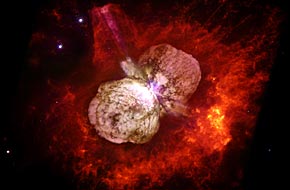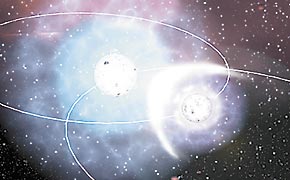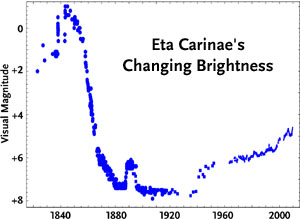"Attention, astronomers! Please keep a close eye on Eta Carinae! It's acting up again."

The Hubble Space Telescope captured the glory of Homunculus Nebula, created in 1843 during an upheaval by the supermassive star Eta Carinae at its center.
Nathan Smith / Jon Morse / NASA
OK, that's not exactly how Dan Green worded the announcement in IAU Circular 9094 on November 11th, but the gist of his alert was crystal clear. On August 19th Kris Davidson and Andrea Mehner (University of Minnesota), along with John Martin (University of Illinois at Springfield) and others, used the Hubble's Space Telescope Imaging Spectrograph (STIS) to show that one of the most massive and unstable stars known has surged in brightness over the past six months. Now at magnitude 5.1, it's fairly easy picking with the unaided eye for southern-sky observers. And there's every indication that more surprises are in the offing.
STIS, by the way, is now back in action after failing in 2004 — and that's especially welcome in this case, since it's too bright to be imaged by Hubble's new Wide-Field Camera 3 (as Martin notes in a comment below).

An artist's concept of Eta Carinae as a binary star of two hot, blue supergiants. In this proposed model, winds from the stars collide, forming an X-ray emitting shock front (thick white arc at center) that wraps around the less powerful of the two stars.
Courtesy Andre Fonseca Silva.
When we last left this rogue star's ongoing saga, researchers were debating whether an 1843 outburst that made Eta Carinae the night sky's second-brightest star resulted from a violent internal explosion or the radiation-driven escape of matter off its surface. And with the realization that Eta Carinae is actually a binary star, there's no way to tell which half is causing trouble — or what will happen next.
With 90 to 100 times the Sun's mass and some 5,000,000 times its luminosity, Eta Carinae's two stars close to within 1 or 2 astronomical units of each other every 5½ years &mdash most recently last January.
Now there's evidence that X-rays created as outflowing winds from these heavyweight suns crash together have strengthened and gained energy, "a possible indicator that the star is entering a new unstable phase of mass loss," according to Michael Corcoran (USRA).

The wild swings in Eta Carinae's brightness span nearly two centuries, punctuated by an astounding drop-off following its peak in 1843, an upward shift in the 1940s, and a resurgence since the 1990s. Click here to see the original graph and its sources.
Eduardo Fern?°ndez-Laj??s & others
This remarkable rogue star is probably in the last gasps of its brief but spectacular life. By some estimates Eta Carinae might take a few thousand years to blow itself to smithereens. But its mimicry of other luminous blue variables that have abruptly become supernovae — such as SN 2006jc, which flared in 2004 and went kapow two years later) has raised speculation that the end might come within our lifetimes or even in a few years!
(Don't worry — it's at least 7,000 light-years away.)
So the deathwatch continues. Astronomers have mounted observing campaigns with the Hubble Space Telescope and at La Plata Observatory in Argentina. Observers also plan to compare notes next January during a meeting of the American Astronomical Society.
 11
11
Comments
Justin S
November 26, 2009 at 9:38 pm
I'll worry if I feel like it. If it produces a gamma ray burst aimed in our direction, that would NOT be good.
You must be logged in to post a comment.
SB
November 27, 2009 at 8:19 pm
Well I wouldn't worry about that as its axis of rotation doesn't seem to point our way.
You must be logged in to post a comment.
John Martin
November 27, 2009 at 9:18 pm
The Star's total output hasn't changed. The main source of the long-term trend in the brightening is the expansion of the surrounding nebula. As it expands it grows thinner and more of the star's light gets through, particularly along our direct line of sight. This was predicted years ago (Martin et al. 2006).
The short term fluctuations are interesting from the perspective that they may reflect changes in the latitudinal structure of the wind due to expected recovery from the 1850 eruption. I think right now the X-ray people are scrambling to explain why the last event was not just a replay of the last but they should have known (see Davidson et al 2003). The answer doesn't have to be this sensational.
FYI, there are also programs on NOAO's Gemini South and ESO's VLT telescopes. Hubble isn't the only game in town. In fact, embarrassingly, we can no longer image the central star for Eta Car with the Hubble because it is now too bright for the newly installed WF3 camera.
You must be logged in to post a comment.
shane
November 28, 2009 at 6:21 pm
There is nothing to worry about...gamma rays don't travel that far and they can't penetrate the atmosphere from 7,000 light years.
You must be logged in to post a comment.
Nico
November 28, 2009 at 9:17 pm
VAMOOO' ETAAAA!!!
You must be logged in to post a comment.
Josh
November 29, 2009 at 10:06 am
Isn't it just our luck that when a super nova finally occurs it would be in the southern hemi. Oh well. Maybe next life time.
You must be logged in to post a comment.
Miles
December 1, 2009 at 10:36 am
Technically we Northerners do have Betelguese, but it isn't supposed to explode for a thousand years or so. Oh well is right then.
You must be logged in to post a comment.
Chardo
December 2, 2009 at 1:50 pm
Possibly the most exciting thing ever to happen in history.If it happens.The first nearby supernova to be studied by modern instruments.Sure those of us in the northern hemisphere may not get to see actual photons from the event,but the results from the professionals will be much more exciting anyway.Can anyone suggest web links so that we can follow what is going on on a daily basis?
You must be logged in to post a comment.
Frank M.
December 2, 2009 at 2:05 pm
In fact, embarrassingly, we can no longer image the central star for Eta Car with the Hubble because it is now too bright for the newly installed WF3 camera.
Perhaps a read or two on the primary use of the WF3 camera is due.
It's not a mistake. Before you start throwing inane descriptors around maybe a little bit of research is in order.
Otherwise, embarrassingly, you sound ignorant and elitist.
You must be logged in to post a comment.
John Martin
December 10, 2009 at 8:00 am
While astronomers attempt to pluck the low hanging fruit half way across the universe, you can still point to just about any star you can see with the naked eye in the night sky and say "we know almost nothing about that." And yet, our understanding of what is happening half-way across the universe is directly built on our understanding of stellar astrophysics in our own galaxy. Not a single premier telescope has been designed with this in mind. It's like knowing the intimate details of Tiger Wood's life and yet not knowing the name of your next door neighbor. I find that embarrassing.
You must be logged in to post a comment.
Enrico the Great
December 16, 2009 at 9:41 pm
What are you 2 fighting about?
This is exciting!
Now KISS AND MAKE UP!!!
You must be logged in to post a comment.
You must be logged in to post a comment.